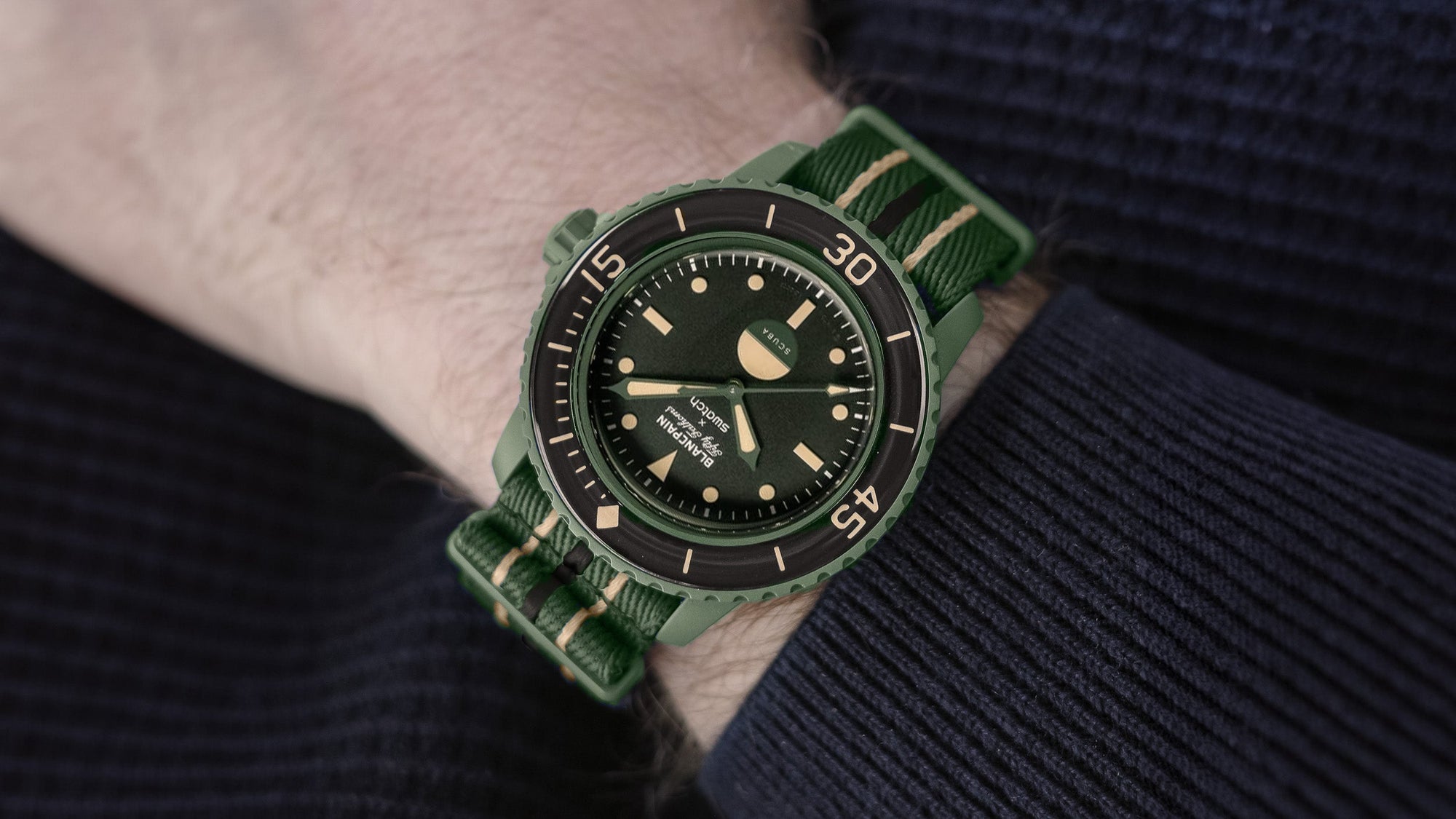The origin of Blancpain x Swatch is the story of two vastly different watchmakers. One is the oldest watch brand in the world, in existence since 1735, and renowned for making some of the most high-end luxury timepieces in the industry, regularly carrying prices of thousands or even tens of thousands of dollars. The other traces its origins only to the 1980s and made its name by producing plastic-cased, mass-market fashion watches for youthful consumers at average prices around $300. Through a convoluted series of events arising from watch-industry upheavals in the late 1990s and early 2000s, the newbie department-store brand bought the historical prestige brand, making it part of a modern-day Murderers Row of legacy watchmakers within what is now known as the Swatch Group.

Both brands continued to do what they did best, and never did their efforts really intersect. Blancpain has adhered to its philosophy of never, in its almost-300-year history, making a watch with a quartz movement. Swatch, by contrast, was the brand that brought quartz into the mainstream of Swiss watchmaking in the first place, and still uses quartz movements in most (but not all) of its voluminous output of watches. But the watchword (no pun intended) of the 21st Century timepiece industry seems increasingly to be, Never Say Never.
The Omega x Swatch MoonSwatch (Obviously)

Omega x Swatch MoonSwatch "Mission On Earth"
In 2022 came a scenario that was somehow both unthinkable and inevitable at the same time. Another of the historical Swiss watch maisons that had become part of the Swatch Group, Omega, collaborated with Swatch on a co-branded version of its undisputed icon, the Speedmaster Professional “Moonwatch,” which would be offered at Swatch-level prices while still boasting classic Omega design.

The seismic effect this release had on the watch business was almost entirely unexpected and is now nearly impossible to overstate. The “MoonSwatch” was a marketing phenomenon rarely seen or equaled in the industry, with watch enthusiasts, both seasoned and newly minted, queuing up for blocks to acquire one from one of Swatch’s brick-and-mortar boutiques. The collaborative piece spawned an entirely new collection within the Swatch portfolio, and very likely (as was certainly intended at the corporate level) also generated interest in the more aspirational Omega brand among a new generation of watch fans.

With the template for success set by the MoonSwatch, the only question that remained as to the expansion of these co-branded editions was, Which iconic watch model within the Swatch Group family of brands would be the next to get its own budget-friendly doppelganger as a follow-up? Initial thoughts turned to another representative from Omega, the luxury brand with the most mainstream name recognition — perhaps a take on the Seamaster, now famous as the watch worn by James Bond in the movies.
However, a handful of us in the curious media — including your humble (but in this case somewhat immodest) author — realized that there was an even more historically significant dive watch in the lineup, one that could, if handled correctly in its Swatch-branded iteration, spark interest in the historic maison behind it: the Blancpain Fifty Fathoms.
Blancpain’s Icon: The First Fifty Fathoms

Blancpain Fifty Fathoms Automatique
The Fifty Fathoms, Blancpain’s most famous timepiece in this modern era, was originally developed as a tool for military divers in the (relatively) recent year of 1953. Jean-Jacques Fiechter, who headed Blancpain at the time, was an avid diving enthusiast who had long wanted to develop a watch that would be ideal for his hobby. Fiechter worked with Captain Robert Maloubier, a French naval officer, to design a reliable, mission-ready timepiece that Maloubier’s elite combat diving team could wear.
The watch’s 42mm steel case — exceptionally large for the time — was water-resistant to 91.45 meters, or 50 fathoms, the maximum depth recommended for scuba divers. Its dial was black and its numerals were luminescent for greater legibility underwater. It was the first divers’ watch with a self-winding movement, the first with an antimagnetic case, and the first to employ the patented, double-sealed crown that Fiechter had developed.

Jacques Cousteau (left) helped popularize diving and the Fifty Fathoms.
Most notably, the Fifty Fathoms was the first watch to include a lockable bezel with dive-time scale that rotated in only one direction. This practical and potentially life-saving innovation prevented a diver from accidentally jarring the bezel in the wrong direction for an inaccurate reading of how much time he’d spent underwater and thus miscalculating how much oxygen he had left in the tank.
The original, military-only model ushered in civilian versions, including one famously worn by Jacques Cousteau in his award-winning undersea documentary, The Silent World. Numerous variations of the Fifty Fathoms were sold in dive equipment shops as well as at jewelers throughout the 1960s and ‘70s, but the model, and many others from traditional Swiss makers, quietly exited the market in the early 1980s as the so-called Quartz Crisis swept over the industry. (Read the full story behind the Fifty Fathoms here.)
Swatch Saves Switzerland

Swatch ad from the 1980s
Ironically, it was the Quartz Crisis that set the stage for the other key player in the story behind the Swatch x Blancpain Scuba Fifty Fathoms line. In 1983, with the Swiss watch industry in economic free fall thanks to the incursion into the market of inexpensive, mass-produced quartz watches from Asia, a team of visionaries composed of Nicolas G. Hayek, Ernst Thomke, Elmar Mock and Jacque Muller, launched the first Swatch watch, planting the flag for the brand as we know it today.
The first Swatch models (the name was derived from a portmanteau for “secondary watch”) captured the Zeitgeist of the go-go ‘80s with their combination of jaunty, colorful analog designs, Swiss-made quartz movements, plastic cases, and price points accessible to all — including the teens and young adults who either hadn’t been wearing watches at all, or were sporting digital timekeepers from the likes of Casio and Pulsar. The Swatch watch cultivated a rabid following throughout that decade and into the next, analogous to the era’s craze over Cabbage Patch Kids and Beanie Babies.

The brilliant “secondary watch” marketing strategy meant that a Swatch should be regarded as a an accessory like a tie, a cap, or a t-shirt: you don’t own just one, and because they were so inexpensive, and available in so many colors and styles, you could own enough of them to accessorize with any outfit and for any occasion. The Swatch was essentially the beginning of today’s “watch wardrobing,” and it also provided the juice needed to rescue the foundering Swiss watch industry, including brands like Blancpain, Omega, and many others, which eventually found a successful renaissance by going back to their stock-in-trade of making high-level timepieces, with traditional mechanical movements, for affluent customers. Swatch continued to play within its well-cultivated, mass-market fashion space, with the occasional foray into niche enthusiast territory with inventions like the Sistem51 automatic movement (more on which later).

Swatch Sistem Sea watch with Sistem51 movement
Fast forward to the MoonSwatch launch in 2022, which opened up an entirely new playing field that was mutually beneficial to both Swatch and its more prestigious —but less widely attainable, and to an extent less widely recognized — luxury maisons. The follow-up in 2023 emerged from the synergy of the now-iconic Fifty Fathoms design language with the crowd-pleasing and colorful execution of the Scuba, a dedicated dive watch that Swatch had introduced way back in 1990 and which had its most recent revamp in the “Scuba Libre” editions of 2013. While calling the Omega version the “MoonSwatch” was a serendipitous no-brainer, the name for the co-branded Swatch x Blancpain model was a bit longer rolling off the tongue: the Bioceramic Scuba Fifty Fathoms. Why “Bioceramic?” Glad you asked.
The Blancpain x Swatch Bioceramic Case

Blancpain x Swatch Bioceramic Scuba Fifty Fathoms Indian Ocean edition, with Blancpain Fifty Fathoms Automatique
Several key elements from the MoonSwatch editions have found a home in the Scuba Fifty Fathoms, while the latter timepiece is drastically different in at least one significant area. To begin with the similarities, the major one is the use of a patented material, which Swatch calls Bioceramic, for the watch’s case. While it resembles and feels like the plastic used on many mainstream Swatch models, the substance is actually composed of two thirds of ceramic and one third of a biosourced material derived from castor oil. The case measures 42.3mm in diameter and 14.4mm thick, with a lug-to-lug distance of 48mm, and features the unidirectional rotating bezel that was once a defining feature of the Fifty Fathoms but is now ubiquitous throughout the dive-watch genre.

Both brands' logos appear on the screw-down crowns.
The watch’s water resistance has been rated to 91 meters, or 300 feet — which is also equivalent to the 50 fathoms that inspired its predecessor’s name. (By way of contrast, today’s version of the Blancpain Fifty Fathoms, in steel, measures 42mm or 45mm, and is rated to an even more intense 300 meters.) The anti-scratch crystal over the dial is also made from biosourced material, and the screw-down crown is inscribed with a Blancpain “JB” (for founder Jehan-Jacques Blancpain) and a Swatch “S” (for… well, you know).
 The Bioceramic buckles sport a Fifty Fathoms inscription.
The Bioceramic buckles sport a Fifty Fathoms inscription.
Each case is mounted on a NATO-style strap, with a striped design color-matched to its respective watch, which is made from recycled fishing nets removed from the ocean depths. The keepers and simple prong buckle are made from the same Bioceramic as the case; an engraved “Swatch” logo appears on the keeper below the dial, and the familiar cursive “Fifty Fathoms” text is etched into the buckle. The back side of the case has its own glass window offering a view of the movement — and here is where we segue into the major difference between this watch and the MoonSwatch editions.
Sistem51 Movement

Whereas the Swatch x Omega MoonSwatch models opt for a quartz movement to power their time, date, and integrated chronograph functions, the simpler three-hand-date Scuba Fifty Fathoms watches turn to the mechanical, self-winding Sistem51 movement, which Swatch debuted to great fanfare in 2013. Then as now, its ingenious, minimalistic architecture cannot fail to impress: Made up of only 51 total parts, configured into an arrangement of five pre-assembled, pre-welded modules, the movement uses only a single screw to fasten everything together. Conventional movements usually have at least twice the amount of parts, and often many more. The Sistem51 is also the first and only mechanical watch movement whose assembly is fully automated, with no hands-on intervention required. Its main parts are made of German silver, which resists rusting by design.

Arctic Ocean caseback, with view of Sistem51 caliber
Because the beat rate is factory-set by laser technology, without the need for manual adjustments, the escapement doesn’t require a regulator, and the movement still manages an impressive precision of -5/+15 seconds per day, and a well-above-average power reserve of 90 hours. Swatch also says that all the parts prior to assembly are housed in a hermetically sealed case, ensuring that no moisture, dust, or other impurities creep into the finished movement to impair its performance over time.
The oscillating weight that winds the movement takes the form of a transparent disk, rotating freely on the single, central screw, providing visual access to the details of the Sistem51 movement behind it, and offering ample opportunity for imprinting specific, model-specific visual elements on the movement itself. Of course, these individual colorways and themes, a hallmark of Swatch in general and the Scuba models in particular, are evident most prominently on the dials.
Blancpain x Swatch Variations

The first wave (if you will) of Blancpain x Swatch Bioceramic Scuba Fifty Fathoms models, which dropped not-at-all-coincidentally in the Fifty Fathoms 70th anniversary year of 2023, consisted of five distinctive models, all named for one of the world’s oceans. They were unified in the case details described above and in their use of the automatic Sistem51 movement — the latter, a fitting tribute to a venerable Swiss watchmaker that takes pride in having never put a quartz movement into a watch — and in the broad strokes of their dials, which at a glance are indistinguishable from that of the classic Fifty Fathoms Automatique.
The skyscraper-shaped hour and minute hands, arrow-tipped seconds hand, Arabic numerals at the four quarter-hours of 12, 3, 6, and 9, wedge-shaped indexes at the other hour positions, and the use of a diamond orientation marker at 12 o’clock on the bezel’s dive scale will all be familiar to fans of the Blancpain model. Distinguishing these Bioceramic models are the use of both a Blancpain and Swatch logo at 12 o’clock and the Ocean-derived colorways.
Blancpain x Swatch Bioceramic Scuba Fifty Fathoms Pacific Ocean
In alphabetical order, the five original models are the Antarctic Ocean (Ref. SO35S100), with a cool gray dial and ice-white-colored case, crown, and bezel; Atlantic Ocean (Ref. SO35A100), with a gradient light-to-dark-blue dial, with blue-tinted case, crown, and bezel; Arctic Ocean (Ref. SO35N100), with beige tones dominating the dial, case, crown and bezel; Indian Ocean (Ref. SO35I100), matching a dark, gradient green dial with a green case, crown, and bezel; and Pacific Ocean, with a white dial that graduates to gray-black at the edges and a case, crown, and bezel in shades of yellow-orange.
All of them feature digital-printed illustrations on their transparent rotors of sea animals called nudibranchs, each carefully chosen to be color-matched to its model’s dial and case, and to represent the individual ocean in which each creature lives, which is in turn depicted on the clear caseback.

Blancpain x Swatch Bioceramic Scuba Fifty Fathoms Atlantic Ocean
Getting back to the dials, two of the first five models feature additional, historically inspired dial elements that call back to distinct eras of the Blancpain Fifty Fathoms. The Arctic Ocean edition enhances its gradient beige dial with a red trefoil on a yellow-orange background, with a white cross in its center.
This circular emblem has long been recognized as the international symbol for “No Radiations,” which is also printed below the dual logos. In the 1960s, back when watchmakers still used mildly radioactive radium for dial illumination, Blancpain applied this symbol to Fifty Fathoms watches, which were often worn by military divers, to trumpet that they didn’t contain radium and thus were safe to wear.

Blancpain x Swatch Bioceramic Scuba Fifty Fathoms Arctic Ocean "NO-RAD"
Another military-inspired symbol adorns the cool grey dial of the Antarctic Ocean edition: a water-contact-indicator disk that Blancpain began using in 1954 for watches slated for use by diving clubs and military units. These watches were often owned by the organization rather than the individual and thus were often passed down to other wearers after initial use. The bicolor indicator, revealed any traces of moisture that had penetrated into the watch from use by a previous diver.
Because this feature was at one point a requirement for a watch used by the U.S. Navy, these models are still famously known as “MIL-SPEC” editions, and, like the “NO-RAD” models described above, are among the rarest and most collectible of Fifty Fathoms watches.

Blancpain x Swatch Bioceramic Scuba Fifty Fathoms Antarctic Ocean "MIL-SPEC"
Much like the MoonSwatch continues to be reinvented into other clever and colorful configurations, the Scuba Fifty Fathoms has also grown as a collection, reaching beyond its original world-oceans theme to more esoteric nautical themes. In early 2024, Blancpain and Swatch added the Ocean of Storms model to the collection, which may have encroached just a bit on the Omega model’s thematic territory with its all-black Bioceramic case and dial, inspired by the huge “Oceanus Procellarum” area of the moon, not technically an ocean or a sea but a large basaltic plain, created by ancient eruptions and impacts from space, which appears as a dark patch on the lunar surface through a telescope. The Blue Lagoon edition, with its vibrant, unmistakably maritime-influenced turquoise-and-blue colorway, debuted later in 2024, bringing things back down to Earth.

Blancpain x Swatch Bioceramic Scuba Fifty Fathoms Blue Lagoon
Most recently, in January 2025, the Pink Ocean edition debuted (you can read more about it here), with the expected and eye-catching pink colorway for the case, dial, and strap. Though surely intended to entice female buyers to the Scuba Fifty Fathoms family, the case maintains the same uncompromising dimensions, contains the same Sistem51 movement, and even stays on-theme with its nudibranch mascot printed on the back: a little-known pink-tinted mollusk called a “Hopkins Rose.”

Clearly, Blancpain and Swatch did not run out of inspirations for its co-branded timepieces when they ran out of Earthly oceans for which to pay tribute. In today’s era of bold color experimentation throughout all tiers of the watch industry, it would follow that many more iterations are still to come — and at an MSRP around $400, as compared to over $10,000 for even the most entry-level Fifty Fathoms from Blancpain proper, the only concern will be for production to keep up with the inevitable ongoing demand.

Blancpain x Swatch Bioceramic Scuba Fifty Fathoms Green Abyss
In June 2025, the Green Abyss iteration of the Scuba Fifty Fathoms was released. Done in a murky green case, this iteration is inspired by the ocean’s unexplored depths. The combination of deep green and beige is matched with black accents on the bezel and there is a bi-colored moisture indicator at 6 o’clock which is a design touch reminiscent of the Antarctic Ocean model.

You’ll also notice the dial doesn’t have the usual date window or hour numerals which also echoes the aforementioned Antarctic Ocean as well as the “NO-RAD” dial model. Finally, the case back here is done in a mossy green color featuring the Felimare picta nudibranch.























































1 Comment
Great synopsis of the Fifty Fathoms collaboration! I’m a big fan, and own both the Ocean of Storms and the Antarctica. Stylish, light, wearable, accurate…what’s not to like?
I do have one question; how is the collab “misunderstood “? I got to the end of the article and was left scratching my head. Is there some controversy that I just missed?